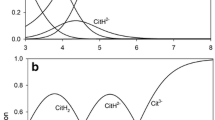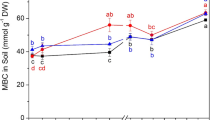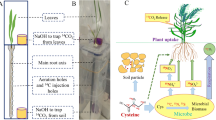Abstract
The re-sorption of carbon compounds from the rhizosphere was investigated using 14C-labelled glucose, mannose and citric acid. Uptake in roots of 5-day-old, intact Zea mays plants in sterile solution culture was determined over a period of 48 hours. Under optimal growth conditions significant re-absorption of glucose and mannose occurred with the uptake rates being 70.5 and 40.2 μg compound g-1 root DW h-1, respectively. For glucose and mannose approximately 25% of the 14C label taken up by the root was recovered inside the plant as low-MW compounds and 33% polymerized into high MW compounds. 42% was respired as 14C-CO2. Citric acid by comparison showed little accumulation within plant tissues (11.4%) with most being respired and recovered as 14C-CO2 in KOH traps (88%). The uptake rate for citric acid was 34.8 μg g-1 root DW h-1. Over the 48-hour period a net efflux (i.e. exudation) of labelled plus unlabelled C was observed at a rate of 608 μg C g-1 root DW h-1 (equivalent to 1520 μg glucose/mannose). Of the C released as root exudates, a minimum estimate of the amount of C taken back into the plant was therefore 9.5%. The two main C fluxes within the rhizosphere, namely release of C by the root and uptake by the microorganisms, have been well documented in recent years. It is now apparent however that a third flux term, re-sorption of C by roots, can also be identified. This may play an important but previously overlooked role within the rhizosphere, and further work is needed to determine its significance.
A comparison between exudate release in static (permitting accumulation of C) and flowing culture (C removed as it is released) was also made with the respective rates being 15.36 and 45.18 mg C g-1 root DW in 2 days. The relative important of re-sorption in natural environments and laboratory experiments is discussed.
Similar content being viewed by others
References
Curl E A and Truelove B 1986 The Rhizosphere. Chapter 2, pp 9–54. Springer-Verlag. Berlin.
Dalal R C 1979 Simple procedure for the determination of total carbon and its radioactivity in soils and plant material. Analysis 104, 151–154.
Darrah P R 1991a Measuring the diffusion coefficients of rhizosphere exudates in soil. II. The diffusion of sorbing compounds. J. Soil Sci. 42, 421–434.
Darrah P R 1991b Models of the rhizosphere. I. Microbial population dynamics around the root releasing soluble and insoluble carbon. Plant and Soil 133, 187–199.
Easton G D and Nagle M E 1985 Timing and root absorption affecting efficiency of Metaxyl in controlling Phytophthora infestans on potato in North Western Washington State. Plant Disease 69, 499–500.
Greenaway W, Scaysbrook T and Whatley F R 1987 The analysis of bud exudate of Populus x euramericana, and of propolis, by gas chromatography-mass spectrometry. Proc. R. Soc. Lond. B 232, 249–272.
Haller Th and Stolp H 1985 Quantitative estimation of root exudation of maize plants. Plant and Soil 86, 207–216.
Hansen G K and Jenson XX 1977 Growth and maintainance respiration in whole plants, tops, and roots of Lolium multiflorum. Physiol. Plant. 39, 155–164.
Haggquist M J, Sevnningsson H, Olsson S, Sundin P, Odham G and Liljenberg C 1984 Long-term culturing of plants with aseptic roots: Determination of rape root exudates. Plant Cell Envir. 7, 549–552.
Hasson-Porath E and Poljakoff-Mayber A 1973 The effect of salinity on glucose absorption and incorporation by pea roots. Plant Cell Physiol. 14, 361–368.
Hendrix D L 1984 Sugar uptake by cotton tissues: Leaf disc versus cultured roots. Plant Physiol. 74, 16–20.
Heulin T, Guckert A and Balandreau J 1987 Stimulation of root exudation of rice seedlings by Azospirillum strains: Carbon budget under gnotobiotic conditions. Biol. Fert. Soils 4, 9–14.
Hoagland D R and Arnon D I 1950 The water culture method for growing plants without soil. Circ. 347, Calif. Agric. Exp. Stn., Berkeley, CA.
Klein D A, Biondini M, Frederick B A and Trlica M J 1988 Rhizosphere microorganism effects on soluble amino acids, sugars and organic acids in the root zone of Agropyron cristatum, A. Smithin and Bouteloua gracilis. Plant and Soil 110, 19–25.
Klein D A, Frederick B A and Redente E F 1989 Fertilizer effects on soil microbial communities and organic matter in the rhizosphere of Sitanion hystrix and Agropyron smithii. Arid Soil Res. Rehab. 3, 397–404.
Kraffczyk I, Trolldenier G and Beringer H 1984 Soluble root exudates of maize: Influence of potassium supply and rhizosphere microorganisms. Soil Biol. Biochem. 16, 315–322.
Liljeroth V, Baath E, Mathiasson I and Lundborg T 1990 Root exudation and rhizoplane bacterial abundance of barley (Hordeum vulgare L.) in relation to nitrogen fertilization and root growth. Plant and Soil 127, 81–89.
Lynch J M 1990 The Rhizosphere. Wiley Interscience. 458 p.
Maschner H 1986 Mineral Nutrition in Higher Plants. Academic Press, London.
McDougall B M and Rovira A D 1970 Sites of Exudation of 14C-labelled compounds from wheat roots. New Phytol. 69, 999–1003.
Meharg A and Killham K 1988 A comparison of carbon flow from pre-labelled and pulse-labelled plans. Plant and Soil 112, 225–231.
Mench M and Martin E 1991 Mobilization of cadmium and other metals from two soils by root exudates of Zea mays L., Nicotiana tabacum L. and Nicotiana rustica L. Plant and Soil 132, 187–196.
Mihashi S, Mori S and Nishizawa N 1991 Enhancement of ferric mugineic acid uptake by iron-deficient barley roots in the presence of excess free mugineic acid in the medium. Plant and Soil 130, 135–142.
Minchin P E H and McNaughton G S 1984 Exudation of recently fixed carbon by non-sterile roots. J. Exp. Bot. 35, 74–82.
Schobert C, Kockenberger W and Komor E 1988 Uptake of amino acides by plants from soil: A comparative study with castor bean seedlings grown under natural and axenic conditions. Plant and Soil 109, 181–188.
Schonwitz R and Ziegler H 1989 Interaction of maize roots and rhizosphere microorganisms. Z. Pflanzenernaehr. Bodenkd. 152, 217–222.
Trofymow J A, Coleman D C and Cambardella C 1987 Rates of rhizodeposition and ammonium depletion in the rhizosphere of axenic oat roots. Plant and Soil 97, 333–334.
Whipps J M 1990 Carbon economy. In The Rhizosphere. Eds. J M Lynch. pp 59–97, Wiley Interscience. 458 p.
Xia J and Saglio P H 1988 Characterization of the hexose transport system in maize root tips. Plant Physiol. 88, 1015–1020.
Yeates G and Darrah P R 1991 Microbial changes in a model rhizosphere. Soil Biol. Biochem. 23, 963–971.
Zhong H and Läuchli A 1988 Incorporation of [14C]glucose into cell wall polysaccharides of cotton roots: Effects of NaCl and CaCl2. Plant Physiol. 88, 511–514.
Author information
Authors and Affiliations
Rights and permissions
About this article
Cite this article
Jones, D.L., Darrah, P.R. Re-sorption of organic components by roots of Zea mays L. and its consequences in the rhizosphere. Plant Soil 143, 259–266 (1992). https://doi.org/10.1007/BF00007881
Received:
Issue Date:
DOI: https://doi.org/10.1007/BF00007881




